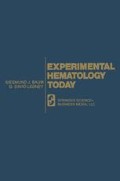Abstract
Clinical graft-versus-host disease (GvHD) occurs in approximately 70% of patients with successful allogeneic marrow grafts (24). The diagnosis of GvHD is made on the basis of clinical impression with pathologic confirmation of involvement in any of the three target organs—the skin, the liver, or the gut. Clinical and histologic criteria have been proposed for staging GvHD on a scale ranging from + to + + + + (24). The pathologic assessment of mild, early GvHD is often difficult. Histologic changes in skin are minimal, and their interpretation is complicated by alterations produced by cytotoxic drugs and radiation. The patient’s clinical condition often precludes a liver or bowel biopsy. The present study was initiated as an attempt to find an easily measurable marker for GvHD not dependent on target-organ damage.
Access this chapter
Tax calculation will be finalised at checkout
Purchases are for personal use only
Preview
Unable to display preview. Download preview PDF.
References
Aye, M. T. Personal communication.
Bradley, T., and Metcalf, D. The growth of mouse bone marrow cells in vitro. Aust. J. Exp. Biol. Med. Sci., 44:287, 1966.
Summer, M. Stimulation of mouse bone marrow colony growth in vitro by conditioned medium. Aust. J. Exp. Biol. Med. Sci., 46: 607, 1968.
Cantor, H., and Weissman, I. Development and function of subpopulations of thymocytes and T lymphocytes. Prog. Allergy, 20:1, 1976.
Chan, S. H., and Metcalf, D. Inhibition of bone marrow colony formation by normal and leukaemic human serum. Nature (London), 227: 845, 1970.
Chervenick, P., and Lobuglio, A. Human Blood monocytes: Stimulators of granulocyte and mononuclear colony formation in vitro. Science, 178: 164, 1972.
Cline, M., and Goldie, D. Production of colony-stimulating activity by human lymphocytes. Nature (London), 248:703, 1974.
Foster, R., Metcalf, D., Robinson, W., and Bradley, T. Bone marrow colony stimulating activity in human sera. Br. J. Haematol., 15:147, 1968.
Granstrom, M. Studies on inhibitors of bone marrow colony formation in normal human sera and during a viral infection. Exp. Cell. Res., 82:426, 1973.
Hara, H., Kitamura, Y., Kawata, T., Kanamuru, A., and Nagai, K. Synergism between lymph node and bone marrow cells for production of granulocytes. II. Enhanced colony-stimulating activity of sera of mice with graft-versus-host reaction. Exp. Hematol. 2: 43, 1974.
Metcalf, D., Chan, S., Gunz, F., Vincent, P., and Ravich, R. Colony stimulating factor and inhibitor levels in acute granulocytic leukemia. Blood, 38:143, 1971.
Mintz, U., and Sachs, L. Differences in inducing activity for human bone marrow colonies in normal serum and serum from patients with leukemia. Blood, 42:331, 1973.
Parker, J., and Metcalf, D. Production of colony-stimulating factor in mixed leukocyte cultures. Immunology, 26:1039, 1974.
Parker, J., and Metcalf, D. Production of colony-stimulating factor in rnitogen-stimulated lymphocyte cultures. J. Immunol., 112:502, 1974.
Pick, E., and Turk, J. The biological activities of soluble lymphocyte products. Clin. Exp. Immunol., 10:1, 1972.
Price, G., McCulloch, E., and Till, J. A new human low molecular weight granulocyte colony stimulating activity. Blood, 42:341, 1973.
Prival, J., Paran, M., Gallow, R., and Wu, A. Colony-stimulating factors in cultures of human peripheral blood cells. J. Natl. Cancer Inst., 53: 1583, 1974.
Robinson, W., and Pike, B. Leukopoietic activity in human urine. New Engl. J. Med., 282:1291, 1970.
Robinson, W., Metcalf, D., and Bradley, T. Stimulation by normal and leukemic mouse sera of colony formation in vitro by mouse bone marrow cells. J. Cell. Physiol., 69: 83, 1967.
Ruscetti, F., and Chervenick, P. Regulation of the release of colony-stimulating activity from mitogen-stimulated lymphocytes. J. Immunol., 114: 1513, 1975.
Sheridan, J., and Stanley, E. Tissue sources of bone marrow colony stimulating factor. J. Cell. Physiol., 78:451, 1972.
Stanley, E., Bradley, T. R., and Sumner, M. Properties of the mouse embryo conditioned medium factor(s) stimulating colony formation by mouse bone marrow cells grown in vitro. J. Cell. Physiol., 78: 301, 1971.
Stanley, E., McNeill, T., and Chan, S. Antibody production to the factor in human urine stimulating colony formation in vitro by bone marrow cells. Br. J. Haematol., 18:585, 1970.
Thomas, E. D., Storb, R., Clift, R. A., Fefer, A., Johnson, F. L., Neiman, P. E., Lerner, K. G., Glucksberg, H., and Buckner, C. D. Bone marrow transplantation. New Engl. J. Med., 292:832, 1975.
Tigelaar, R., and Asofsky, R. Graft-versus-host reactivity of mouse thymocytes: Effect of cortisone pretreatment of donors. J. Immunol., 110:567,1973.
Wewerka, J., and Dale, D. Colony stimulating factor in patients with chronic neutropenia. Blood, 47: 861, 1976.
Grebe, S., and Streilein, J. W. Graft-versus-host reactions: A review. Adv. Immunol., 22: 119, 1976.
Editor information
Editors and Affiliations
Rights and permissions
Copyright information
© 1977 Springer Science+Business Media New York
About this chapter
Cite this chapter
Singer, J.W., James, M.C., Thomas, E.D. (1977). Serum Colony Stimulating Factor: A Marker for Graft-versus-Host Disease in Humans. In: Baum, S.J., Ledney, G.D. (eds) Experimental Hematology Today. Springer, Berlin, Heidelberg. https://doi.org/10.1007/978-3-662-25807-1_25
Download citation
DOI: https://doi.org/10.1007/978-3-662-25807-1_25
Publisher Name: Springer, Berlin, Heidelberg
Print ISBN: 978-3-540-90208-9
Online ISBN: 978-3-662-25807-1
eBook Packages: Springer Book Archive

